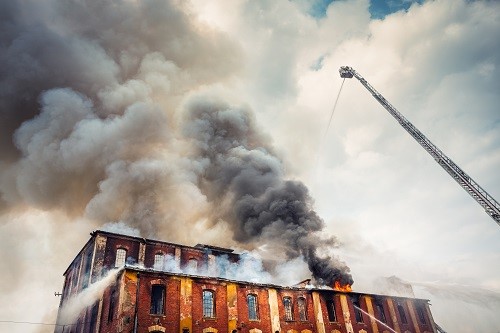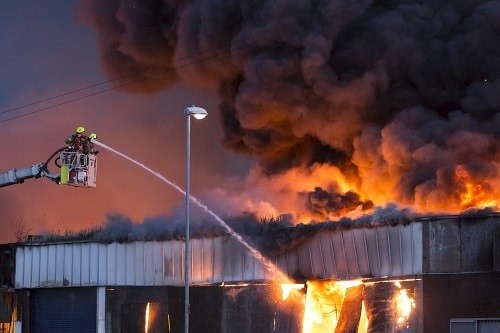With many buildings across the UK temporarily unoccupied as a result of the Covid-19 lockdown, property owners and responsible persons must do everything possible to prevent the risk of fires starting and spreading.
Features
Idle and at risk
While fires can easily start as a result of faulty or poorly maintained electrical and gas supplies, idle buildings are not as regularly inspected or monitored to assess the level of risk posed by fire, making them more vulnerable to arson attacks.
Every day, up to 60 fires occur in or next to an empty property in the UK. According to statistics published by the National Fire Chiefs Council, arson accounted for 50.5 per cent of all fires attended in 2017/18 by Fire and Rescue Services in the whole of the United Kingdom, making it the single largest cause of fire attended (of the 213,782 fires attended, 108,024 were deliberate).
 Arson accounted for 50 per cent of all fires attended in 2017/18 by Fire and Rescue Services
Arson accounted for 50 per cent of all fires attended in 2017/18 by Fire and Rescue Services
What’s more, despite crime rates dropping during the Covid-19 outbreak, arson attacks have continued to prevail, with significant cases in Northern Ireland and Newcastle having occurred during the lockdown.
Fire and explosion incidents caused in excess of £12.6 billion worth of losses in the UK from 2013 to 2018, with arson contributing £2.1 billion to the total cost of fire damage in England and Wales per annum.
Given the fact that so many of these costs can be easily avoided by implementing the appropriate preventative safety measures, it is important for employers to keep on top of these while their buildings are unoccupied to keep the level of risk from fire as low as possible.
Precautionary measures
In light of the current pandemic, it is easy for those maintaining temporarily unused buildings to overlook fire safety risks, with the focus having shifted to planning and implementing control measures that will help to lower the risk of transmission from Covid-19 once facilities are back up and running.
Nevertheless, fire safety is just as important to maintain – if not more so – while your buildings remain unattended, given that they will not be assessed or monitored as frequently.
 Employers are legally required to carry out a suitable and sufficient risk assessment of your idle building
Employers are legally required to carry out a suitable and sufficient risk assessment of your idle building
When managing the risk of fire in buildings currently undergoing extended periods of closure, key precautionary measures that can be taken to combat the level of risk include:
- Checking that all valuable stock has been removed or secured properly
- Disabling, turning off or isolating any services that are not required (e.g. water, electricity, gas supplies)
- Servicing and regularly monitoring all fire alarms and sprinkler systems.
The storage of combustible and flammable materials might not have been properly thought out prior to a building being shut down. A significant and substantial risk of fire is caused by a build-up of ‘heavier than air’ vapour or gases in low-lying areas, or in a confined space/room with poor ventilation in a building that would normally disburse them.
Leakage of flammable or combustible liquids that may pool at a low level also causes a considerable level of risk. Dust build-up on horizontal surfaces or inside machinery could serve as a source of fuel, which only requires exposure to an ignition source when the plant and equipment is restarted.
Damage to wiring can also be caused by to vermin gnawing through cables, leaving them exposed and more susceptible to ignition.
There will be an opportunity for responsible persons to review the fire loading associated within the building and implement measures to remove any combustible items – including waste, fixtures and fittings – that might provide fuel for a fire. Arrangements to defuel the idle building should be made, such as emptying any oil tanks, closing and locking shut valve hoods fitted to external LPG tank controls and keeping tank stands clear of vegetation.
A build-up of unread mail can also be a significant fire hazard, so while the building is temporarily unused, redirect mail, seal up any letterboxes and, where necessary, install a fire reduction letterbox.
Internal security
Unauthorised access to vacant premises poses a high level of fire risk, whether from arson committed by youths looking for something to do or by vagrants looking to warm themselves in cold weather.
 Fire and explosion incidents caused in excess of £12.6 billion worth of losses in the UK from 2013 to 2018
Fire and explosion incidents caused in excess of £12.6 billion worth of losses in the UK from 2013 to 2018
For the past few months, special arrangements have been made by the UK government to provide the homeless with temporary shelter. However, this funding is soon to run out, which will unfortunately lead to homeless individuals looking for other means of accommodation – an easy target being premises that have been closed or are unlikely to reopen any time soon as a result of the Covid-19 lockdown.
As part of an idle building’s internal security measures, ensure that all smoke and heat detectors are functioning and that part of the alarm has not been isolated if a fault has been identified.
If the building’s sprinkler systems have been isolated for any reason, your insurer must be notified, as otherwise this may invalidate your policy and protection. The risk of an accidental fire starting by overloaded sockets or poor storage around electrical points and power units must also be considered.
It may also be the case that fixed or portable electrical items that were left unattended during the lockdown period have exceeded their re-inspection dates. Fire detection equipment such as extinguishers may also need to be inspected and serviced, so making all of the necessary inspections and checks on electrical and fire safety equipment before you reopen your premises is essential.
Having internal security measures in place – such as a combined alarm/camera system – will alert both the responsible person/s and the authorities not only that the idle building is on fire but that an individual may be trapped inside. This can be instrumental in lessening the risk of damage to property and saving the lives of employees, third parties and firefighters. It is particularly important in cases of buildings that catch fire as a direct result of being adjacent to the premises that originally caught fire, as these may not necessarily be unoccupied.
Perimeter security
It is important to ensure that premises are secure and regularly checked for signs of unauthorised access, with measures in place to deter would-be thieves from targeting buildings and committing acts of vandalism, burglary and malicious damage, including arson.
Responsible persons should consider the security risk from access barriers being deactivated as a result of Covid-19 and how this can increase the risk of an arson attack. The premises may be in a partially occupied area that experiences a lot of activity, making the building more susceptible to a would-be villain or arsonist.
It is therefore recommended that you invest in additional security measures by upgrading your perimeter fencing or implementing exterior lighting and detection systems, such as burglar alarms and CCTV. Additional physical measures that could be implemented include:
- Ensuring that all windows and doors have secure locks and that these are used
- Boarding up all accessible windows with secure panels
- Securing access ladders.
Legislative requirements
Whether you are an employer, employee or responsible person, it is your legal duty to ensure that your business complies with health and safety, environmental and public legislation, which can vary from sector to sector.
Alongside the Regulatory Reform (Fire Safety) Order 2005, which requires employers in England and Wales to take all reasonable steps to reduce the risks posed by fire and ensure that people can safely escape if there is one, a host of relevant legislation also applies which, if correctly adhered to, can further reduce the risks posed by fire.* These include:
- Dangerous Substances and Explosive Atmosphere Regulations (DSEAR) 2002
- Construction (Design and Management) Regulations 2015
- Control of Substances Hazardous to Health (COSHH) Regulations 2002
- Health and Safety at Work Act 1974
- Electricity at Work Regulations 1989
- Gas Safety (Installation and Use) Regulations 1998
- Lifting Operations and Lifting Equipment Regulations (LOLER) 1998
- Pressure Systems Safety Regulations (PSSR) 2000
- Provision and Use of Work Equipment Regulations (PUWER) 1998
- Work at Height Regulations (WAH) 2005
- Workplace (Health, Safety and Welfare) Regulations 1992
- HSE Approved Code of Practice L8 for Management of Water Systems and Legionella.
You are also legally required to carry out a suitable and sufficient risk assessment of your idle building, which will help you to understand the potential risks of fire and take action where necessary to improve precautionary measures.
The risk assessment must be carried out by a competent person and take into account such factors as the size of the premises, the nature of activities that usually take place, all groups who may potentially be at risk and the maximum number of employees/persons that may be present at any one time. Businesses with five or more employees must also ensure that they have a written record of the fire safety risk assessment.
Chris Power is Training manager/principal consultant, health & safety at SOCOTEC UK
FEATURES

Sedentary working and how to combat the ‘sitting disease’
By Gavin Bradley, Active Working on 05 April 2024
Prolonged and excessive sitting poses a major risk to our health, but the Get Britain Standing campaign and On Your Feet Britain Day on 25 April are a great way of encouraging workers to sit less and move more.

Company culture and wellbeing: a crucial link
By Bex Moorhouse, Invigorate Spaces on 05 April 2024
Investing in measures to support worker wellbeing will be ineffective unless the company culture genuinely incorporates values like teamwork, involvement, flexibility and innovation.

Office design and culture: happier and healthier staff – or the opposite?
By Guy Osmond, Osmond Ergonomics on 03 April 2024
Applying ergonomic principles to workstation set-ups and ensuring the physical environment supports neurodivergent people are just some of the ways of creating an office where everyone can thrive, but a supportive and positive organisational culture is vital too.


